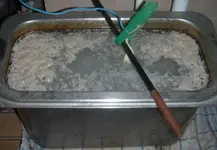batcap
Hero Member
- Joined
- Jun 22, 2010
- Messages
- 684
- Reaction score
- 131
- Golden Thread
- 0
- Location
- Baltimore MD
- Detector(s) used
- AT PRO
I use a model railroad transformer, but only do relatively small items. With a transformer with a "speed controller" you can be quite gentle.
You can successfully do "whatzit" coins if you keep an eye on them. I turned an unknown large cent into one that I could determine was a braided hair Liberty. I could read "Liberty" in her headband, but still couldn't get the date. Way better than a brown disk with a raised area where a wreath *might* belong.
I use baking soda because I heard about bad gasses when you use salt. I understand washing soda is better yet.
You can successfully do "whatzit" coins if you keep an eye on them. I turned an unknown large cent into one that I could determine was a braided hair Liberty. I could read "Liberty" in her headband, but still couldn't get the date. Way better than a brown disk with a raised area where a wreath *might* belong.
I use baking soda because I heard about bad gasses when you use salt. I understand washing soda is better yet.





